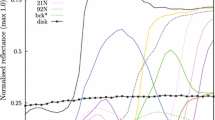Summary
Innate behavioural reactions, i.e. reactions of untrained, flower-naive bumblebees (Bombus terrestris L., B. lucorum L.; Apidae) were observed in flower dummy experiments. It was proven that an innate releasing mechanism responds to optical flower signals: the spectral purity of ‘corolla colour’ was found to be crucial for far attraction toward flower dummies. During the subsequent near orientation, that is when a bumblebee finally reaches a flower dummy, the bumblebee's antennae contact the part of highest spectral purity while the bee is still in flight. ‘Guides’ such as ‘stamen patches’ present in the center of flower dummies are used only for near orientation. Flower dummies receiving the greatest number of antennae reactions at the guide were always those with low spectral purity in the surrounding background colour, high spectral purity at the corolla colour and highest spectral purity at the guide colour. In contrast, dominant wavelength and intensity of flower dummy colours had no detectable influence on innate behavioural reactions, while colour contrast had some. These results are interpreted as follows: orientation toward guides is based upon a gradient of centripetally increasing, bee-subjective colour saturation which directs the bumblebee's approach toward the center of the flower dummy where additional factors may contribute to stimulating the landing reaction.
Similar content being viewed by others
References
Backhaus W, Menzel R (1987) Color distance derived from a receptor model of color vision in the honeybee. Biol Cybern 55:321–331
Backhaus W, Werner A, Menzel R (1987) Color vision in honeybees: metric, dimensions, constancy and ecological aspects. In: Menzel R, Mercer A (eds) Neurobiology and behavior of the honeybee. Springer, Berlin Heidelberg New York Tokyo, pp 172–190
Daumer K (1956) Reizmetrische Untersuchung des Farbensehens der Bienen. Z Vergl Physiol 38:413–478
Daumer K (1958) Blumenfarben, wie sie die Bienen sehen. Z Vergl Physiol 41:49–110
Dobson HEM (1987) Role of flower and pollen aromas in hostplant recognition by solitary bees. Oecologia 72:618–623
Frisch K von (1915) Der Farbensinn und Formensinn der Biene. Zool Jb Physiol 35:1–182
Frisch K von (1923) Über die Sprache der Bienen. Zool Jb Physiol 40:1–186
Grant V (1950) The flower constancy of bees. Bot Rev 16:379–398
Helversen O von (1972) Zur spektralen Unterschiedsempfindlichkeit der Honigbiene. J Comp Physiol 80:439–472
Jacobs-Jessen UF (1959) Zur Orientierung der Hummeln und einiger anderer Hymenopteren. Z Vergl Physiol 41:597–641
Kugler H (1935) Blütenökologische Untersuchungen mit Hummeln VII. Die Anlockung von ‚Neulingen’ durch Blüten. Planta 23:692–714
Kugler H (1950) Der Blütenbesuch der Schlammfliege (Eristalomyia tenax). Z Vergl Physiol 32:328–347
Kugler H (1963) UV-Musterungen auf Blüten und ihr Zustandekommen. Planta 59:296–329
Lunau K (1988a) Attrappenversuche mit blütennaiven Hummeln zum Nachweis angeborener Verhaltensreaktionen auf Blütensignale. Doctoral-thesis, University of Freiburg, FRG, 219 pp
Lunau K (1988b) Angeborenes und erlerntes Verhalten beim Blütenbesuch von Schwebfliegen — Attrappenversuche mit Eristalis pertinax (Scopoli) (Diptera, Syrphidae). Zool Jb Physiol 92:487–499
Mazokhin-Porshnyakov GA (1962) Kalorimetrischer Nachweis des trichromatischen Farbensehens bei den Bienenartigen (am Beispiel der Hummel). Biofizika 7:211–217
Menzel R (1967) Untersuchungen zum Erlernen von Spektralfarben durch die Honigbiene (Apis mellifica). Z Vergl Physiol 56:22–62
Menzel R (1987) Farbensehen blütenbesuchender Insekten. Internationales Büro der Kernforschungsanlage Jülich GmbH (ed):1–15
Michener CD (1974) The social behavior of bees. A comparative study. Belknap Press of Harvard University Press, Cambridge
Neumeyer C (1980) Simultaneous color contrast in the honeybee. J Comp Physiol A 139:165–176
Neumeyer C (1986) Wavelength discrimination in the goldfish. J Comp Physiol A 158:203–213
Oettingen-Spielberg T zu (1949) Über das Wesen der Suchbiene. Z Vergl Physiol 31:454–489
Osche G (1983) Optische Signale in der Coevolution von Pflanze und Tier. Ber Dtsch Bot Ges 96:1–27
Ribbands CR (1953) The inability of honeybees to communicate colours. Br J Anim Behav 1:5–6
Schefler WC (1969) Statistics for the biological sciences. Adison-Wesley, Reading
Tinbergen N (1979) Instinktlehre, 6th edn. Parey, Berlin
Author information
Authors and Affiliations
Rights and permissions
About this article
Cite this article
Lunau, K. Colour saturation triggers innate reactions to flower signals: Flower dummy experiments with bumblebees. J Comp Physiol A 166, 827–834 (1990). https://doi.org/10.1007/BF00187329
Accepted:
Issue Date:
DOI: https://doi.org/10.1007/BF00187329




